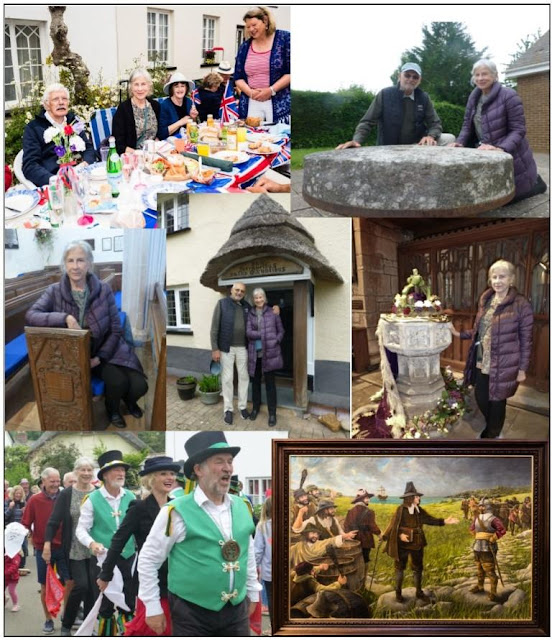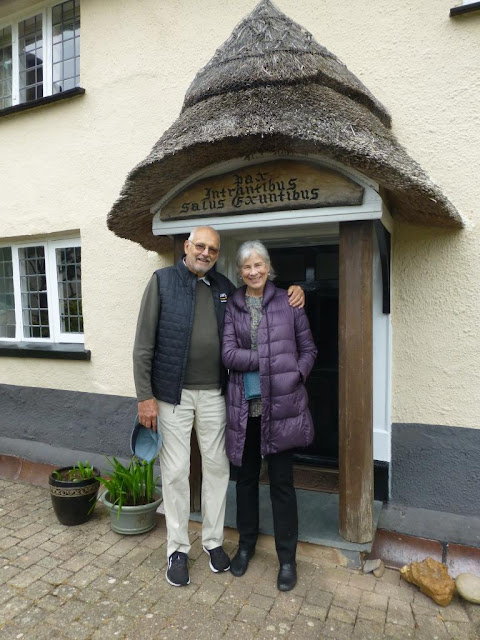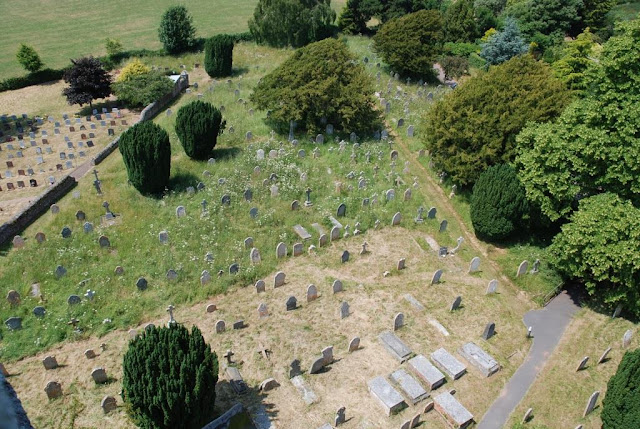Roger Conant’s descendants have been thrilled to learn about the activities of the East Budleigh-based local history group which has been investigating the Devon origins of the founder of Salem, Massachusetts. Roger’s 9x-granddaughter, retired psychologist Luli Graetch, flew with her husband Frank all the way from California to spend some time in the area over the recent Jubilee weekend. They learnt about other aspects of East Budleigh, the village where in the 16th century two important figures in the history of America were born.
Passing Hayes Barton, birthplace of Sir Walter Ralegh on Hayes Lane, a mile or so west of East Budleigh: the word ‘barton’ simply meaning a farm. The house is not open to the public
Vicars Mead on Hayes Lane, where the young Walter Ralegh and Roger Conant are likely to have received their early schooling from East Budleigh’s vicar
Frank and Luli outside Vicars Mead, which is not open to the public. The Latin inscription ‘Pax intrantibus salus exuntibus’ is often translated into English as "Peace to those who enter, good health to those who depart
A group of local residents have set up the Roger Conant 400 Club. They plan to erect a blue plaque near the millstone commemorating his voyage to America in about 1623
At East Budleigh’s Jubilee Street Party on Sunday 5 June 2022.Tables
were set up the length of the High Street for a community lunch. Naturally the
pub provided much of the food and drink
Luli is sitting next to historian and East Budleigh resident Ian Blackwell who is researching for a book about Roger Conant
East Budleigh is entertained at the Street Party by Exeter Morris Men, the oldest established Morris Men in Devon. Could there have been Morris dancing in the time of Ralegh and Roger Conant? Maybe. The earliest English written mention of Morris dance is dated to 1448
All Saints Church dates mainly from the 12th and 15th centuries, and is where the Ralegh and Conant families worshipped. Roger’s father and grandfather were churchwardens here, as was Ralegh’s father. Photo by Peter Bowler
The churchyard of All Saints seen from the tower. John Conant, Roger’s grandfather, together with his parents Richard and Agnes, were buried here, but the gravestones have long gone. Luli and Frank were given a copy of the excellent guide to the churchyard recently produced by Paul and Penny Kurowski. It focuses on wildlife, but includes a paragraph about the millstone and Roger Conant, as well mentioning some of the graves and memorials, such as those to James Lackington (1746-1815) and Admiral George William Preedy (1817-1894)
Frank and Luli at the porch of All Saints Church
Roger was baptised at All Saints on 9 April 1592, in what is thought to be the original font
The bench end of the 'Conant pew' bears the arms of Nathaniel Conant, who was knighted in 1813. He was Roger Conant's great-great-great-great-nephew, had never visited America, and probably not East Budleigh
All Saints is noted for much more ancient bench ends like this one. Does it really depict a Native American? Or, as most historians think, a ‘Green Man’ figure from traditional folk culture?
And does this bench end really depict a man eating a banana brought back by East Budleigh sailors from across the Atlantic? Or is it telling us that tale bearers and gossips will be punished with swollen tongues?
A bench end showing a ship is said to have inspired young Walter Ralegh with a love of seafaring. In fact historians tell us that he suffered badly from seasickness
The list of East Budleigh clergy includes Roger’s nephew Richard Conant, son of Richard Conant the younger, and vicar at All Saints for over 16 years from 1672. He was buried in East Budleigh on 6 December 1688, and was succeeded by Daniel Caunieres, a Huguenot refugee forced to flee his home in France because of religious persecution
This painting displayed at All Saints is a copy of one of the best known portraits of Sir Walter Ralegh formerly attributed to the 16th century Italian artist Federico Zuccaro but now to the monogrammist 'H' (? Hubbard) and dated 1588. It shows Ralegh in court dress at the height of his favour with Queen Elizabeth I. Ralegh had been appointed Captain of the Guard in 1587. Did Ralegh really meet Roger Conant in East Budleigh? It’s a nice story, but no historical evidence has been found for it
One of the treasures of All Saints, not on public view, is the
Elizabethan silver chalice from which the Ralegh and Conant families would
have drunk while at church. It was made between 1571 and 1576, possibly by the
Exeter goldsmith John Jones. This replica is on display in the Ralegh Room at
Budleigh Salterton’s Fairlynch Museum
By chance, while in All Saints Church, Luli met East Budleigh resident Cathy Moyle who has spent many years investigating local history, including leading the restoration of the Salem Chapel on the outskirts of the village
On the way to the nearby village of Otterton where they were staying, Luli and Frank had a good view of this Dissenters’ chapel, built in 1719. Sadly it is now closed. Salem Chapel has no connection with the city of Salem, Massachusetts, founded by Roger Conant. ‘Salem’ simply means ‘Peace’ in Hebrew and Arabic
Further towards Otterton, at a crossroads stands the Brick Cross. The brick pedestal was erected in 1743 as a direction post, but the cross dates from 1580 when the Sheriff of Exeter is recorded as having ordered the burning of a witch at the site
The King’s Arms pub stands on the main street of Otterton. The village is as picturesque as East Budleigh, celebrated for its beautifully thatched roofs and quaint cob and brick cottages
On the other side of the street is Otterton Mill. There has been a working mill in the village since at least Norman times
Luli and Frank managed to include a visit to the coastal
town Budleigh Salterton, which is within walking distance of Otterton,
following the River Otter. People interested in stories of British royalty may
like to know that Diana, Princess of Wales, is said to have enjoyed walking
incognito on Budleigh beach with her lover James Hewitt
Just a few yards from the beach is Fairlynch
Museum, a picturesque thatched building of the type known as a cottage orné. It
dates from around 1810 and was built by a local merchant. The Museum's Ralegh Room is located on the 1st floor
At Bicton, a mile or so from Otterton, Luli and Frank visited the studio of John Washington, the local artist whose painting ‘Blessed are the Peacemakers’ depicts the events of 1625 in New England where Roger Conant played a key role. They also met Stan Roberts, Chair of the Roger Conant 400 Club. Image credit: Peter Bowler
Our American visitors had a great time in East Devon. ‘This has been a whirlwind and wonderful trip,’ wrote Luli. ‘Please know how grateful we are to you for bringing our ancestry to life. I can’t imagine not coming back.’
With acknowledgement to Ian Blackwell for some of the historical details in the text.



























